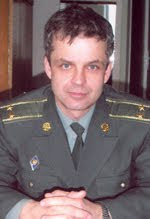 Newton, Iowa. - The sculptor Vladyslav Dymion has spent the last few weeks crouching over a 3-ton slab of limestone in a warehouse here on the town's west side. With a towel draped over his hair and a surgical mask strapped around his mouth and nose, he chisels away at a monument dedicated to the American and Soviet armies who met in Germany, signaling the end of World War II. He works long days and often well into the evening, pushing to meet a double deadline: Saturday, when the Iowa Sculpture Festival opens a few blocks away at Iowa Telecom's Innovation Center, and Monday, when his visa expires, forcing him to return to his native Ukraine.
Newton, Iowa. - The sculptor Vladyslav Dymion has spent the last few weeks crouching over a 3-ton slab of limestone in a warehouse here on the town's west side. With a towel draped over his hair and a surgical mask strapped around his mouth and nose, he chisels away at a monument dedicated to the American and Soviet armies who met in Germany, signaling the end of World War II. He works long days and often well into the evening, pushing to meet a double deadline: Saturday, when the Iowa Sculpture Festival opens a few blocks away at Iowa Telecom's Innovation Center, and Monday, when his visa expires, forcing him to return to his native Ukraine.He took a break last week to explain, through a translator, some of the elements of the design: the grooved waves of a river, the rough arches of a bridge and two giant hands, locked in a handshake. Together, the symbols commemorate the events of April 25, 1945, when "an American infantry officer and a Russian private squirmed across a girder of a blown bridge in the Elbe river" in Germany, according to an account two days later in the Newton Daily News. The two men "pounded each other on the back and shook hands to seal a historic meeting of Gen. (Courtney) Hodges' First army with Marshal Ivan S. Konev's First Ukrainian army group . . . The union of the two great armies climaxed sensational drives from the west and east and ended intense suspense along the front over which unit would be the first to make the junction."
The meetings at the Elbe and several other locations in Germany stitched up the last pockets of Nazi-controlled territory. Soldiers from Iowa, including Hubert Porter of Atlantic, were among the troops that led the way. "The war was over, that was the important thing," recalled Porter, who was 21 at the time. "We were done fighting. We cared about nothing else." He remembers walking across the remnants of the bombed-out bridge - "you kind of had to hang on" - and meeting the soldiers from Ukraine. There were language barriers, but they got along just fine. "All they had was plenty of vodka, and they could drink it by the water-glassful, holy mackerel. They'd give some to us, and we couldn't keep up," he said.
 http://www.desmoinesregister.com/article/20100608/ENT01/6080328/-1/FAMOUSIOWANS/Pivotal-World-War-II-meeting-caught-in-stone
http://www.desmoinesregister.com/article/20100608/ENT01/6080328/-1/FAMOUSIOWANS/Pivotal-World-War-II-meeting-caught-in-stone

0 comments:
Post a Comment